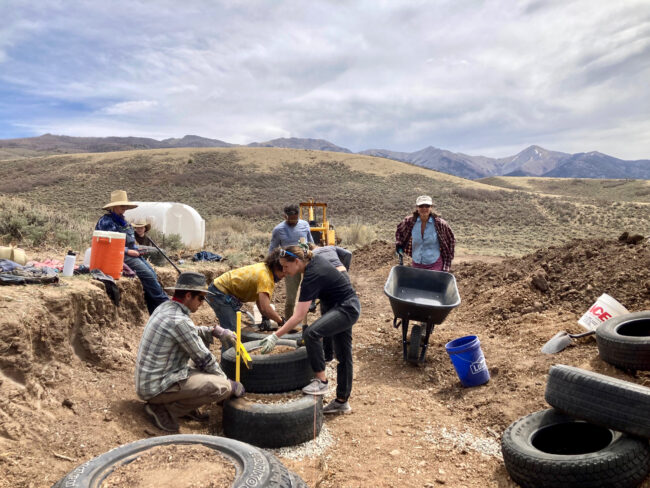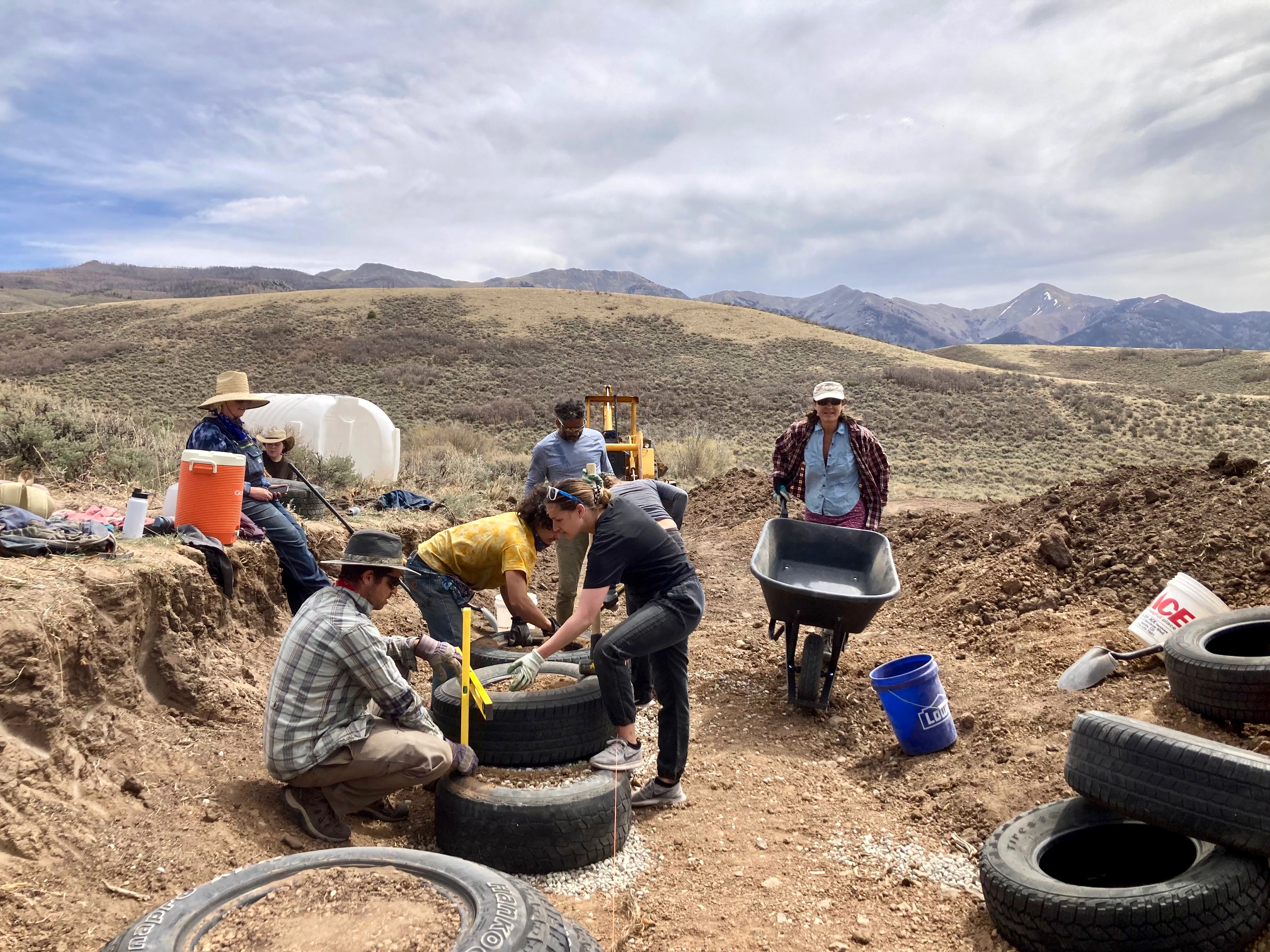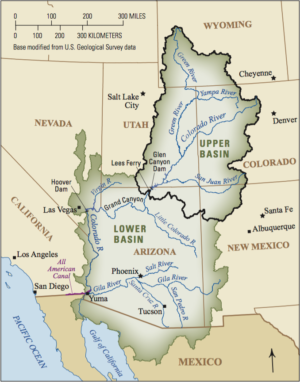
IT’S A DELICIOUS, IF TORTUROUS, CYCLE WITH ME: just when I’m on the brink of throwing up my hands and writing all humanity off as a wretched lot of uberconsumerist, plastic-mongering jackasses who deserve to suffocate in the ozone-depleted bed we’ve made for ourselves — lo and behold, some brightly shining soul or earth-conscious initiative pops up out of the proverbial woodwork, torch held high to light a new, restorative way forward, and voila! — restored is my faith in humanity and our ability, just maybe, to reverse this course of destruction we’ve trod these many centuries.
I met one such soul atop Poncha Pass this spring, rubber mallet in hand and sweating over a row of tires salvaged from local tire shops’ discard piles. Former marine biologist Chris White is building his future home with about a dozen dust-caked students who’d shown up to pitch in while learning his 0-carbon home-building principles. The result, maybe two years or more down the road, will be a completely carbon-neutral earthship with 100% solar heat in the winter and non-powered cooling provided by the earthen walls all summer long.
Under the expansive Poncha Pass sky, White led his band of helpers in stacking old tires into a long, tidy row, which would eventually be stacked 10 tires high to create the earthen north wall of the home. Each tire the crew adds to the row must be filled first with a base layer of cardboard or plastic bags, then wheelbarrows full of dirt and rubble. Taking turns with the pickaxe and rubber mallet, White and his students pound the earthen filling into the tires until there’s no flex left in the rubber walls. The next step will be filling in between the tires with other recyclables like glass and cans.
The final structure, White says, will consist almost entirely of materials reclaimed from local waste streams or from the earth. “The point of the cans and bottles is to reduce the use of concrete, which is one of the biggest carbon emitters,” White explains, noting that for every pound of concrete produced, eight pounds of CO2 are emitted. He’ll have to use some concrete to fill gaps, but the bulk of the space is taken up by those recyclables and pounded dirt and rocks. A mixture of sand, clay, straw and water will create the adobe that will encase any parts of the walls that aren’t already encased in good old terra firma.
The only other non-recycled material is the glass he’ll use for the structure’s south-facing wall. But the carbon footprint of that glass is easily offset by the amount of sunlight it allows the earthship to harness for heating and, of course, for growing food and other plants.
“Why don’t we build all our houses with a greenhouse on the south side?” White wonders aloud, and I find myself scheming how to incorporate a greenhouse into my own home’s long south-facing wall. Why not indeed!
White offered two, two-week classes in May, and he’ll offer another pair of classes in October, registration for which is currently open with several seats available. The first part of each class day is spent in the dirt, physically constructing the earthship, while getting intermittent lessons and practical instructions from White. Around noon the workers close up the construction site for the day and head to the nearby yurts for lunch. Then, in the afternoon they reconvene for the classroom portion of the day. White offers lectures on a wide range of topics pertaining to sustainable building, everything from how to build a composting toilet to building permit applications and creating a business plan. Other topics include the history of yurt building; installing water, power and sewer; grafting trees; recovering graywater; prioritizing maintenance over repair; fire mitigation; building affordable furniture and appliances; time banking, and how to build communities around work exchanges.
Students at the early May class I visited hailed mostly from around Colorado, with a few from Texas, and a couple of young women from “the road.” They enroll in the almost free classes ($200 to cover groceries for the 2-week course) for a variety of reasons but mostly because they want to learn how to build sustainably. Some of them will go on to build their own earthships or help build them for others, and some will take the principles home to incorporate into their own communities and houses. Alan Marshall of Pueblo, for instance, says he plans to use the principles he’s learned from the course to retrofit his existing family home so that he can cut back on his utilities consumption and generally reduce his impact on the planet.
“I didn’t come up with these techniques,” White said. “A lot of First Nations used building practices that are far more sustainable and practical than modern suburban stick-built construction.” Specifically, he mentioned the yurt builders of Mongolia, igloos of the Eskimos and tipis of bison-hunting tribes. He also pointed to some time he spent in Taos, New Mexico, learning design concepts and construction principles from the community of earthship builders there.
“If I could take the core ideas and apply them to my own, I felt I might be able to stand on the shoulders of giants and take the idea of sustainable and affordable housing further. … It’s my hope that [my students] can stand on my shoulders and realize sustainable living practices just a bit easier, faster and more affordably. That’s the ultimate goal, to build it and help others more easily realize it for themselves.”
Yurts at Poncha Pass
Before he started construction of the earthship, White and some colleagues built four yurts on the 40-acre plot of rolling, mountaintop hills. One yurt serves as a gathering space for the classes and occasional yoga retreats hosted onsite, and the other three are set up as lodgings that can accommodate up to 4 people, complete with bathrooms and kitchenettes.
During the shoulder seasons of May and October, the yurts serve as student housing, which is provided free to each student in exchange for their participation in the earthship-building endeavor. Then in the winter, the yurts offer affordable housing for a handful of local seasonal workers, most of whom camp or travel during the summer months. Last winter, White was able to house three ski patrollers and a raft guide in the yurts. Then in the summer months, White offers the yurts to vacationers, at admittedly less affordable rates.
“The vacation rental aspect of the yurts allows us to subsidize the affordable housing we offer during the rest of the year,” White explains. Additionally, vacationers generate recyclables for construction materials. And they also receive an education of sorts by their time in the yurts: by living in these one-room but fully equipped yurts, White says folks with big, sprawling homes often learn how much less they need than they think.
To learn more about Chris’s mission, to read about or sign up for his October classes, or to support the affordable housing initiative he’s spearheading, visit yurtsatponchapass.com. If you’ve got friends or family hoping to visit our sunny state this summer — especially ones who spend their bulk of their lives in refrigerated, carbon-belching McMansions — consider pointing them toward the yurts for their lodgings. They just might learn a thing or two about how simple life can be when it’s lived in concert with the natural world rather than in conflict with it.
Jess is a sometime journalist, called into (slow) action when she catches wind of a locally-beneficial initiative her fellow Rockies dwellers need to be appraised of. She is also completely fine with ending sentences in prepositions and breaking other rules that are outdated or arbitrary.
This article is sponsored by Mark Zander and Leslie Champ.



